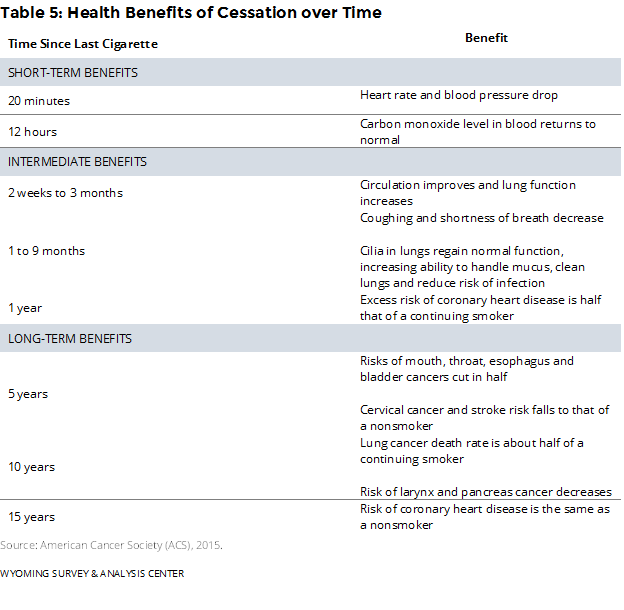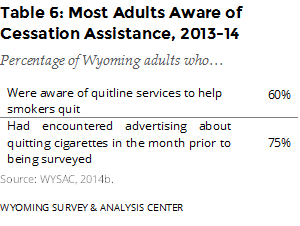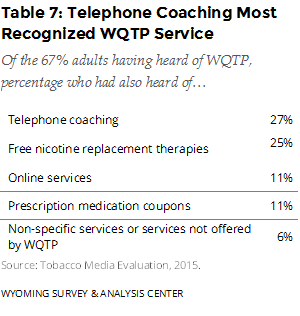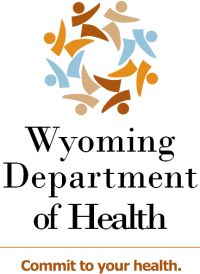Tobacco Cessation
 Benefits of Cessation
Benefits of Cessation
Smoking cessation has various short- and long-term health benefits (Table 5). Some health effects of smoking cessation (e.g., increased lung functioning) are evident within a few weeks or months of quitting, suggesting that relatively brief periods of abstinence have health benefits. Others (e.g., reduced risk of stroke) are not fully evident for five years or longer, reflecting the long-term benefits of successful smoking cessation (American Cancer Society [ACS], 2015). Additional research suggests that smoking cessation stops pathogenic processes which lead to cancer (CDC, 2010).
Cessation among Wyoming Smokers
In 2012, 86% of current smokers had made a quit attempt during their lifetime; 55% of those smokers had tried to quit within the previous year (WYSAC, 2014a).
 Among current smokers who tried to quit in the previous year, 62% did not use the Wyoming Quit Tobacco Program (WQTP) or proven medications (nicotine replacement therapy [NRT] or prescription medications such as Chantix) during their most recent quit attempt. The most popular cessation aid was NRT: 28% of current smokers who had made a quit attempt within the previous year used NRT (WYSAC, 2014a). Most Wyoming adults said they were aware of cessation quitlines and advertisements for cessation services (Table 6; WYSAC, 2014b).
Among current smokers who tried to quit in the previous year, 62% did not use the Wyoming Quit Tobacco Program (WQTP) or proven medications (nicotine replacement therapy [NRT] or prescription medications such as Chantix) during their most recent quit attempt. The most popular cessation aid was NRT: 28% of current smokers who had made a quit attempt within the previous year used NRT (WYSAC, 2014a). Most Wyoming adults said they were aware of cessation quitlines and advertisements for cessation services (Table 6; WYSAC, 2014b).
The Wyoming Quit Tobacco Program (WQTP)
The WQTP assists Wyoming residents who want to quit using tobacco by offering them telephone-based cessation coaching and nicotine replacement therapies (NRTs) or prescription medications. In addition, the WQTP offers online, texting, and email support services. National Jewish Health has been the WQTP service provider since 2013.
 In 2015, 67% of Wyoming adults reported having heard of the “Wyoming Quit Tobacco Program or WQTP.” The most well-known WQTP services were telephone coaching and NRTs (Table 7; Tobacco Media Evaluation, 2015).
In 2015, 67% of Wyoming adults reported having heard of the “Wyoming Quit Tobacco Program or WQTP.” The most well-known WQTP services were telephone coaching and NRTs (Table 7; Tobacco Media Evaluation, 2015).
WYSAC conducts monthly surveys of WQTP enrollees seven months after their enrollment for the Wyoming Department of Health, Public Health Division. Every six months, WYSAC generates a report primarily based on this follow-up survey. In this document, WYSAC presents stable patterns in the results from those surveys. The most recent version of that report can be found here: https://wysac.uwyo.edu/wyomingtobacco/topic/cessation/.
WYSAC’s evaluation of WQTP has found that a plurality of WQTP enrollees hear about the program primarily from healthcare professionals. Many others learn of the program primarily from family members and friends or television.
The majority of people who enroll in the WQTP do so to get help quitting cigarettes, though some seek help quitting smokeless tobacco, ENDS, and/or other tobacco (e.g., cigars, cigarillos, little cigars, hookah, and pipes).
More than half of WQTP enrollees use the combination of medication and coaching. Generally, seven months after enrollment, about one fourth of WQTP survey respondents have succeeded in quitting tobacco use. Success is defined as not having used tobacco in the 30 days prior to completing the survey. Enrollees who use coaching and medication often see the greatest success rates.

